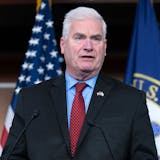In 15th century Florence, a rebirth of arts and culture inspired by Greek and Roman antiquity resulted in a humanistic outlook.
The Minneapolis Institute of Art's exhibition "Botticelli and Renaissance Florence: Masterworks from the Uffizi," opening Oct. 16, brings that sensibility into the present. Visitors to the exhibit will be greeted by a mural of Renaissance Florence and drawings of the city surrounded by a stone wall.
The special project brings more than 45 loaned works from Renaissance Florence to Minneapolis. The exhibit includes paintings, drawings, prints and decorative arts by Sandro Botticelli, his teacher Fra Filippo Lippi, and colleagues Domenico Ghirlandaio, Cosimo Rosselli and Pietro Perugino, as well as a selection of ancient Roman marble sculptures that inspired the artists.
"I love the idea that in the Renaissance there's this rebirth of naturalism that comes from seeing the antique, and then there is also this idea that there was this past that was previously unknowable," said Katie Luber, Mia's director and president. "And I think that's true for us still, right? We have a hard time thinking about what was it like to live in the 1470s, '80s and '90s Florence, when there's no indoor plumbing, electricity, or washing machines."
The collaboration began two years ago. Luber reached out to Eike Schmidt, former curator of sculpture, applied art and textiles at Mia from 2009-15, now director of the Uffizi Gallery.
"Thinking of COVID and the unrest that the city went through, I think it's something that we can very much relate to with the Renaissance where a new visual language was developed," Schmidt said. "It was a return to millennia-old scholarship that really helped rekindle the interest in learning, human values and social values, and I think that's something people nowadays can relate to."
The prospering of Renaissance Florence was due largely to the political ascendancy of the Medici family, an Italian banking family that came to power during the first half of the 15th century. Cosimo de' Medici became one of Italy's wealthiest individuals, and his lineage had four popes, including Pope Leo X. The Medici family is known as one of the great patrons of the Renaissance and in art history.
Intro to Renaissance Florence



